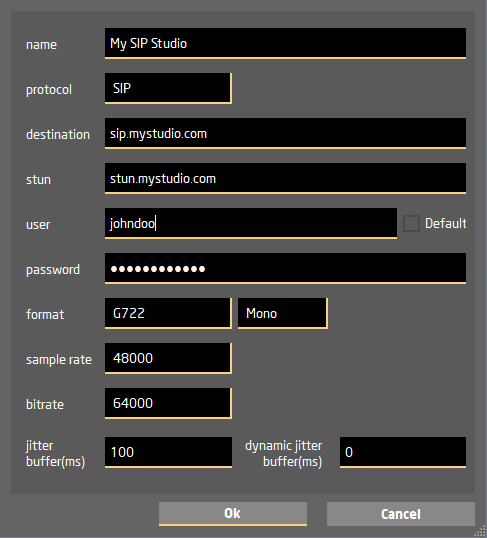 By choosing Add / Edit station you will see the dialog for setting up a new station, or changing the selected station.
By choosing Add / Edit station you will see the dialog for setting up a new station, or changing the selected station.
Your new station will at first use the same settings as the currently loaded station.
name : Fill in the name of your station. Always start by giving the new station a name, otherwise it will not be saved. In this case we will name it Studio 1 and alter the settings.
protocol : The following supported protocols can be set:
RTP: send and receive a symmetric RTP stream with integrated signalling.
SC-RTP: send and receive a symmetric RTP stream with integrated signalling. Send the same stream on all available active network-interfaces. So when you have a 3G and a WIFI connection, LUCI will send 2 streams. This way, if 1 connection breaks up, the studio will still receive the other. In addition to this, LUCI will send also streams via IPV4 and IPV6 if the network-interface and the studio support it.
SIP: You can use SIP in combination with formats like G711, G722 to connect to standard VOIP equipment. Or use other codecs like AAC-HE or MP2 to connect to other SIP compliant codecs.
SC-SIP: as SC-RTP sending the same stream on all available active network-interfaces.
Shoutcast: LUCI can be a source for a Shoutcast internet radio station you operate.
Icecast: LUCI can be a source for an Icecast internet radio station you operate.
destination : The connection details of the server/studio codec.
For protocol RTP
Use an IP-address or URL, combined with a : and the IP port number,
examples: 83.163.21.56:5042 or echo.lucilive.com:5042
For Protocol SIP *
Use CODEC@SIPSERVER or CODEC (when there is no SIPserver) where SIPSERVER is the URL or IP-address of the SIPserver.
examples: echo@iptel.org or 102409@167.45.7.234 or 102.78.90.45
For Protocol Shoutcast or Icecast
Use an IP-address or URL.
examples: 83.163.21.56 or shoutcast.lucilive.com
 stun : Only valid for the SIP protocol, when needed.
stun : Only valid for the SIP protocol, when needed.
Use an IP-address or URL.
examples: 83.163.21.56 or stun.iptel.org
default : Only valid for the SIP protocol, when needed. Switch on if you want to use the credentials of the default user that you have set in ‘Options > SIP > Defaults’
user : Your username is the name you use to login at your server. Only fill in username if you want to log in to a SIP, Shoutcast or Icecast server.
password : Your password is your personal log on credential belonging to your username. Passwords are used only together with usernames for logging in to SIP, Shoutcast or Icecast servers.
jitter buffer : Default value 100 ms (WiFi) / 200 ms (3G). Supported buffer length WiFi and 3G: 10 ms to 500 ms. This is the jitter buffer that LUCI uses for the RETURN stream. This will NOT have any influence on the outgoing stream to the studio.
dynamic jitter buffer : This is a setting that you can choose so the software determines the buffer that is needed to get a drop free connection automatically while you are streaming. It takes the normal jitter buffer setting ( say 50 ms ) as the lowest possible, and the Jitter Buffer Dyn. setting ( say 200 ms ) as the possible range ( so buffer automatically set is between 50 and 250 msec ). 0 ms will set this feature off.
format : Select here one of the following audio codec formats for the outgoing stream to the studio:
AAC(-LC), AAC-ELD, AAC-LD, AAC-HE or AAC-HE v2
G.711 A-Law or G711 u-Law
G.722
L16 or L24
MP2
Opus Audio, Opus Low Delay or Opus Voice
ULCC, ULCC-24 or ULCC-S
stereo : Default is Mono. Select Stereo if you want to broadcast in Stereo, and the chosen codec ( ‘Stations > New station > Streaming’) supports it.
bitrate : Default value is set on 64 kbps. Set the bitrate of the codec format you select.
For the outgoing stream.
Supported bitrates depend on the chosen codec.
frames : This is valid for the MP2 and AAC-HE format, you can set the number of Audio frames Luci sends per packet. This will lower the effective bitrate (Rb as indicated in the drop down menu) and also decrease the packet-rate (p/s), without affecting the audio quality. A lower frame- and bit-rate can improve the reliability of the connection in some conditions.
sample rate : Default value 48KHz. Set Sample-rate of the codec format you selected for the outgoing stream.
Talk Back mode ( Push to Talk ) : Kind of Walkie-Talkie mode to be able to only listen, and only talkback by pressing a button. Similar to a Talk button on a studio mixing console. For live studio music mix / voice-over producers reviews or other applications were you do not want to use headphones.
Overview for the supported codecs and bitrates
| AAC-LC mono > 56 – 256 kbps | L24 mono > 1280 kbps |
| AAC-LC stereo > 96 – 384 kbps | L24 stereo > 2116 kbps |
| AAC-ELD mono > 18 – 64 kbps | MP2 mono > 40 – 192 kbps |
| AAC-ELD stereo > 32 – 128 kbps | MP2 stereo > 112 – 256 kbps |
| AAC-HE mono and stereo> 12 – 64 kbps | Opus Audio mono > 18 – 192 kbps |
| AAC-HE v2 stereo > 18 – 64 kbps | Opus Audio stereo > 64 – 384 kbps |
| AAC-LD mono > 50 – 192 kbps | Opus Low Delay mono > 18 – 64 kbps |
| AAC-LD stereo > 76 – 384 kbps | Opus Voice mono > 18 – 64 kbps |
| G.711 A-Law mono > 64 kbps | ULCC mono > 252 kbps |
| G.711 u-Law mono > 64 kbps | ULCC stereo > 492 kbps |
| G.722 mono > 64 kbps | ULCC-24 mono > 276 kbps |
| L16 mono > 705 kbps | ULCC-24 stereo > 540 kbps |
| L16 stereo > 1058 kbps | ULCC-s mono > 51 kbps |
